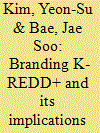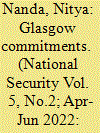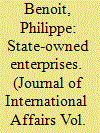|
|
|
Sort Order |
|
|
|
Items / Page
|
|
|
|
|
|
|
| Srl | Item |
| 1 |
ID:
171518


|
|
|
|
|
| Summary/Abstract |
California law requires statewide greenhouse gas (GHG) emissions to return to 1990 levels by 2020—a goal achieved in 2016, four years early. We conduct the first independent retrospective analysis of California's greenhouse gas emissions to assess how the state has achieved faster-than-expected emissions reductions. We analyze the extent to which economic activity, climate policies, and market forces drove California's greenhouse gas emissions trends overall and in two key categories: electricity and light-duty vehicles. We also compare historical trends with business-as-usual and policy expectations from the 2008 Climate Change Scoping Plan, California's official strategy for achieving the 2020 emissions limit. Our analysis, based on data through 2017, indicates that reduced economic activity during the 2008–2009 recession and its aftermath has been a major contributor to early achievement of the 2020 emissions limit. Policies and market forces, however, have played a larger role in reducing emissions in recent years—particularly in the electricity sector, which has decarbonized more rapidly than expected. Meanwhile, GHG emissions from light-duty vehicles in recent years were rising, not falling, in contrast to expectations. Our analysis demonstrates how decomposition methods can be used to track climate policy implementation and inform future policy development.
|
|
|
|
|
|
|
|
|
|
|
|
|
|
|
|
| 2 |
ID:
165145


|
|
|
|
|
| Summary/Abstract |
The need for new and stronger middle power diplomacy is growing as global challenges are increasingly governed by various horizontal inter- and trans-national networks. Climate change is one of the most complex and urgent global challenges that require collective action, and it is an issue for which more middle power leadership is greatly needed. The Republic of Korea (ROK) has been successful in becoming a primary actor in green growth governance, and its success has been attributed to its strategic middlepowermanship, integrating both material and ideational contents. Reducing emissions from deforestation and forest degradation (REDD+) in tropical developing countries has been lauded as an immediate and effective solution to mitigate climate change. ROK's unique history of forest transition before rapid economic growth highlights the fact that improving forest management is possible even with imperfect governance, rapid population growth, and low economic development. The lessons learned from ROK's forest transition can be developed as a distinct contribution to the international effort to address forest-related impacts on climate change, and offer an important opportunity for ROK to play a constructive role and achieve enhanced stature within the international community.
|
|
|
|
|
|
|
|
|
|
|
|
|
|
|
|
| 3 |
ID:
137272


|
|
|
|
|
| Summary/Abstract |
As the threats of climate change grow, the need to reduce carbon dioxide (CO2) emissions from fossil fuel burning is increasingly acknowledged by governments around the world. The potential of carbon capture and storage (CCS), a set of technologies that offers a politically appealing vision of a ‘cleaner’ way to use fossil fuels, has provided powerful motivation for large public and private investments in CCS technology. But investing in CCS is controversial because, although some consider it a critical climate mitigation technology, others view it as an expensive fossil fuel subsidy that could inadvertently perpetuate, rather than reduce, fossil fuel reliance.
|
|
|
|
|
|
|
|
|
|
|
|
|
|
|
|
| 4 |
ID:
180640


|
|
|
|
|
| Summary/Abstract |
Climate change is a leading threat to sustainable socio-economic development in Bangladesh. Adverse impacts of climatic disasters including flash floods, recurrent cyclones and erratic rainfall patterns are already causing hardship for both rural and urban people and are expected to accelerate into the future. The aim of this research note is to identify the core contributing economic sectors to climate change in Bangladesh, and to consider effective mitigation strategies. Following the 5th Assessment Report (AR5) of the Intergovernmental Panel on Climate Change (IPCC) report (2014), in this paper, we argue that comprehensive mitigation measures are required in the energy, transport, buildings, industry and land-use sectors to reduce Greenhouse Gas (GHG) emissions. Our findings indicate that it is crucial that government and non-government mitigation efforts engage with community knowledge practices in order to most effectively reduce GHG emissions and combat the adverse impacts of climate change.
|
|
|
|
|
|
|
|
|
|
|
|
|
|
|
|
| 5 |
ID:
186236


|
|
|
|
|
| Summary/Abstract |
India made ambitious commitments on climate mitigation in its first Nationally Determined Contribution (NDC) in 2015 and upgraded it further at the Glasgow summit in 2021. Additionally, it made a commitment to achieve a net-zero emission level by 2070. While some of the NDC commitments may be difficult to realise, particularly due to the current economic situation, it is difficult to comment on the feasibility of the net-zero emission by 2070 as the basis for such a commitment is not known, and it is a long-time horizon, making any prediction difficult. For India, living up to its commitment will not only be determined by its own internal factors and challenges but also by how other major countries perform on their mitigation commitments. Similarly, the implications of the Glasgow summit will not be determined by its own commitments, but the commitments made by others and their follow-up actions.
|
|
|
|
|
|
|
|
|
|
|
|
|
|
|
|
| 6 |
ID:
112911


|
|
|
|
|
| Publication |
2012.
|
| Summary/Abstract |
Climate mitigation at the local level plays a highly important role in greenhouse gas (GHG) emissions mitigation. This research presents a summary of the local efforts in China's ecological industrial parks (EIPs) to assess GHG emissions and identify potential mitigation measures. Through field study and interviews in Suzhou Industrial Park (SIP), in Jiangsu Province, we conducted an energy-based GHG emissions inventory for SIP area from 2005-2010, with forecasts to 2015. The area emitted a total of 10.30 MMT CO2E in 2010. Three development strategies including business-as-usual (BAU), existing and pending regulations (EPR) and voluntary mitigating efforts (VME) were introduced to estimate the energy-related GHG emissions in 2015. The results projected that emissions will increase to 17.16 Mt in 2015 with no change in policy or practice, but 3.42 Mt of emissions are avoidable with full compliance with national and provincial energy policies (1.41 Mt), as well as local efforts (2.01 Mt). This study furthers the understanding of the potential effectiveness of carbon reduction strategies of industrial parks in China, including the development industrial symbiosis (IS) and on-site renewable energy projects.
|
|
|
|
|
|
|
|
|
|
|
|
|
|
|
|
| 7 |
ID:
176713


|
|
|
|
|
| Summary/Abstract |
Despite similarities in their current energy mixes, France and Sweden's pathways have been very different since the 1970s, when both systems were highly dependent on fossil fuels. After the oil crisis, both countries chose to reduce their oil consumption by developing nuclear power. However, Sweden pursued a more diversified energy policy that has subsequently allowed it to reduce its CO2 emissions. Today, both countries have committed to a carbon neutrality goal: by 2045 for Sweden and 2050 for France. In order to understand the key factors that can drive energy transition toward a carbon neutrality goal, we propose to compare the past energy transitions in France and Sweden, two countries that have significantly reduced their CO2 emissions and fossil fuel dependency. To assess the impacts of the current energy system and its regulations on the feasibility of meeting carbon neutrality, we use TIMES bottom-up energy system optimization models. The results show that France faces more challenges in transforming its energy system than Sweden i.e. an increase in power production, a decrease in gas consumption, the replacement of heating systems in buildings, and the electrification of industry, thus confirming that its energy policy has to be driven with a long-run perspective.
|
|
|
|
|
|
|
|
|
|
|
|
|
|
|
|
| 8 |
ID:
122746


|
|
|
|
|
| Publication |
2013.
|
| Summary/Abstract |
Climate science suggests that, to have a high probability of limiting global warming to an average temperature increase of 2 °C, global greenhouse gas emissions must peak by 2020 and be reduced to close to zero by 2040. However, the current trend is heading towards at least 4 °C by 2100 and little effective action is being taken. This paper commences the process of developing contingency plans for a scenario in which a sudden major global climate impact galvanises governments to implement emergency climate mitigation targets and programs. Climate activists assert that rapid mitigation is feasible, invoking the scale and scope of wartime mobilisation strategies. This paper draws upon historical accounts of social, technological and economic restructurings in several countries during World War 2 in order to investigate potential applications of wartime experience to radical, rigorous and rapid climate mitigation strategies. We focus on the energy sector, the biggest single contributor to global climate change, in developed and rapidly developing countries. We find that, while wartime experience suggests some potential strategies for rapid climate mitigation in the areas of finance and labour, it also has severe limitations, resulting from its lack of democratic processes.
|
|
|
|
|
|
|
|
|
|
|
|
|
|
|
|
| 9 |
ID:
121285


|
|
|
|
|
| Publication |
2013.
|
| Summary/Abstract |
The overall goal of the UNFCCC is to prevent dangerous anthropogenic interference with the climate system. In policy practice, this goal is mainly operationalized through three types of mitigation targets: emission, atmospheric concentration and temperature targets. The typical function of climate mitigation goals is to regulate action towards goal achievement. This is done in several ways. Mitigation goals help the structuring of the greenhouse gas (GHG) abatement action, over time and between agents; they constitute a standard against which GHG abatement can be assessed and evaluated; they motivate climate conscious behavior; and discourage defection from cooperative abatement regimes. Although the three targets clearly relate to one another, there could be differences in how well they fulfill these functions. In this article, the effectiveness of emission, concentration and temperature targets in guiding and motivating action towards the UNFCCC's overall aim is analyzed using a framework for rational goal evaluation developed by Edvardsson and Hansson (2005) as an analytical tool. It is argued that to regulate action effectively, mitigation goals should ideally satisfy four criteria: precision, evaluability, attainability and motivity. Only then can the target fulfill its typical function, i.e., to guide and motivate action in a way that facilitates goal achievement.
|
|
|
|
|
|
|
|
|
|
|
|
|
|
|
|
| 10 |
ID:
111316


|
|
|
|
|
| Publication |
2012.
|
| Summary/Abstract |
Passenger car traffic is among the main contributors to anthropogenic greenhouse gas (GHG) emissions, which are responsible for climate change. It is also an important indicator used to forecast these emissions in integrated climate-economic models. This paper develops scenarios for global passenger car stock until 2050. The study adopts a global regionalized approach, encompassing 11 world regions. Car stock projections are obtained using a multi-model approach, which includes a consumer demand model based on utility maximization, a non-linear Gompertz model and a panel estimate of the income elasticity of demand for cars. The main hypothesis underlying these projections is that preferences for purchasing cars are similar across cultures and nations and that the demand for cars is largely determined by disposable income. We apply scenarios for the average traffic volume and fuel efficiency developed in previous work together with the average carbon content of fuels to obtain the CO2 emissions.
|
|
|
|
|
|
|
|
|
|
|
|
|
|
|
|
| 11 |
ID:
170842


|
|
|
|
|
| Summary/Abstract |
State-owned enterprises (SOEs), in the aggregate, emit more energy greenhouse gases than the entire European Union and every country except China. SOEs are also major providers of zero-carbon power and other low-carbon alternatives. Succeeding in the low-carbon transition will require their engagement. Yet, they receive relatively little attention in the global dialogue on climate mitigation. In contrast to private sector companies, many of these SOEs operate under conditions that mute the impact of carbon pricing mechanisms. Moreover, they have government owners that can and are willing to use their shareholder power to support low-carbon SOE action. These distinctive features of SOEs alter the suite of climate policies and instruments to influence their operations to lower emissions. Government ownership of SOEs can provide a useful avenue for effective climate action, with the right tools . . . but challenges exist, particularly government ambivalence about climate action. Given the important but under-appreciated and under-analyzed role that SOEs will have to play in reducing emissions, this paper will identify some of the opportunities and challenges in generating greater SOE engagement in the low-carbon transition, a climate outcome that cannot happen without them.
|
|
|
|
|
|
|
|
|
|
|
|
|
|
|
|
|
|
|
|
|